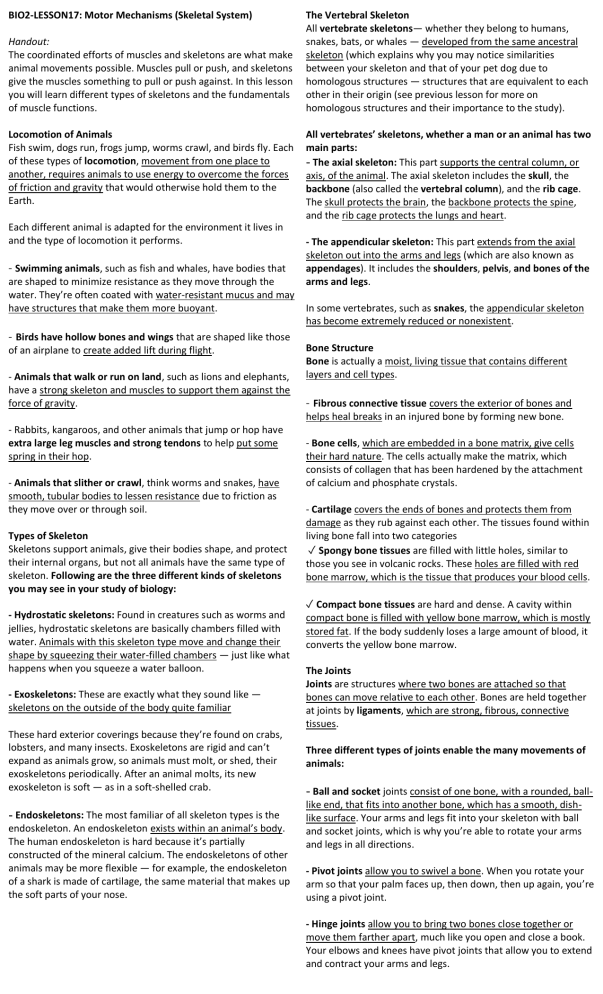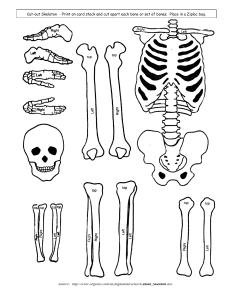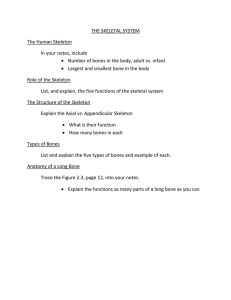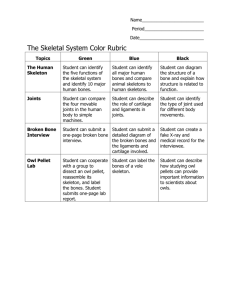
BIO2-LESSON17: Motor Mechanisms (Skeletal System) Handout: The coordinated efforts of muscles and skeletons are what make animal movements possible. Muscles pull or push, and skeletons give the muscles something to pull or push against. In this lesson you will learn different types of skeletons and the fundamentals of muscle functions. Locomotion of Animals Fish swim, dogs run, frogs jump, worms crawl, and birds fly. Each of these types of locomotion, movement from one place to another, requires animals to use energy to overcome the forces of friction and gravity that would otherwise hold them to the Earth. Each different animal is adapted for the environment it lives in and the type of locomotion it performs. - Swimming animals, such as fish and whales, have bodies that are shaped to minimize resistance as they move through the water. They’re often coated with water-resistant mucus and may have structures that make them more buoyant. - Birds have hollow bones and wings that are shaped like those of an airplane to create added lift during flight. - Animals that walk or run on land, such as lions and elephants, have a strong skeleton and muscles to support them against the force of gravity. - Rabbits, kangaroos, and other animals that jump or hop have extra large leg muscles and strong tendons to help put some spring in their hop. - Animals that slither or crawl, think worms and snakes, have smooth, tubular bodies to lessen resistance due to friction as they move over or through soil. Types of Skeleton Skeletons support animals, give their bodies shape, and protect their internal organs, but not all animals have the same type of skeleton. Following are the three different kinds of skeletons you may see in your study of biology: - Hydrostatic skeletons: Found in creatures such as worms and jellies, hydrostatic skeletons are basically chambers filled with water. Animals with this skeleton type move and change their shape by squeezing their water-filled chambers — just like what happens when you squeeze a water balloon. - Exoskeletons: These are exactly what they sound like — skeletons on the outside of the body quite familiar These hard exterior coverings because they’re found on crabs, lobsters, and many insects. Exoskeletons are rigid and can’t expand as animals grow, so animals must molt, or shed, their exoskeletons periodically. After an animal molts, its new exoskeleton is soft — as in a soft-shelled crab. - Endoskeletons: The most familiar of all skeleton types is the endoskeleton. An endoskeleton exists within an animal’s body. The human endoskeleton is hard because it’s partially constructed of the mineral calcium. The endoskeletons of other animals may be more flexible — for example, the endoskeleton of a shark is made of cartilage, the same material that makes up the soft parts of your nose. The Vertebral Skeleton All vertebrate skeletons— whether they belong to humans, snakes, bats, or whales — developed from the same ancestral skeleton (which explains why you may notice similarities between your skeleton and that of your pet dog due to homologous structures — structures that are equivalent to each other in their origin (see previous lesson for more on homologous structures and their importance to the study). All vertebrates’ skeletons, whether a man or an animal has two main parts: - The axial skeleton: This part supports the central column, or axis, of the animal. The axial skeleton includes the skull, the backbone (also called the vertebral column), and the rib cage. The skull protects the brain, the backbone protects the spine, and the rib cage protects the lungs and heart. - The appendicular skeleton: This part extends from the axial skeleton out into the arms and legs (which are also known as appendages). It includes the shoulders, pelvis, and bones of the arms and legs. In some vertebrates, such as snakes, the appendicular skeleton has become extremely reduced or nonexistent. Bone Structure Bone is actually a moist, living tissue that contains different layers and cell types. - Fibrous connective tissue covers the exterior of bones and helps heal breaks in an injured bone by forming new bone. - Bone cells, which are embedded in a bone matrix, give cells their hard nature. The cells actually make the matrix, which consists of collagen that has been hardened by the attachment of calcium and phosphate crystals. - Cartilage covers the ends of bones and protects them from damage as they rub against each other. The tissues found within living bone fall into two categories ✓ Spongy bone tissues are filled with little holes, similar to those you see in volcanic rocks. These holes are filled with red bone marrow, which is the tissue that produces your blood cells. ✓ Compact bone tissues are hard and dense. A cavity within compact bone is filled with yellow bone marrow, which is mostly stored fat. If the body suddenly loses a large amount of blood, it converts the yellow bone marrow. The Joints Joints are structures where two bones are attached so that bones can move relative to each other. Bones are held together at joints by ligaments, which are strong, fibrous, connective tissues. Three different types of joints enable the many movements of animals: - Ball and socket joints consist of one bone, with a rounded, balllike end, that fits into another bone, which has a smooth, dishlike surface. Your arms and legs fit into your skeleton with ball and socket joints, which is why you’re able to rotate your arms and legs in all directions. - Pivot joints allow you to swivel a bone. When you rotate your arm so that your palm faces up, then down, then up again, you’re using a pivot joint. - Hinge joints allow you to bring two bones close together or move them farther apart, much like you open and close a book. Your elbows and knees have pivot joints that allow you to extend and contract your arms and legs.




